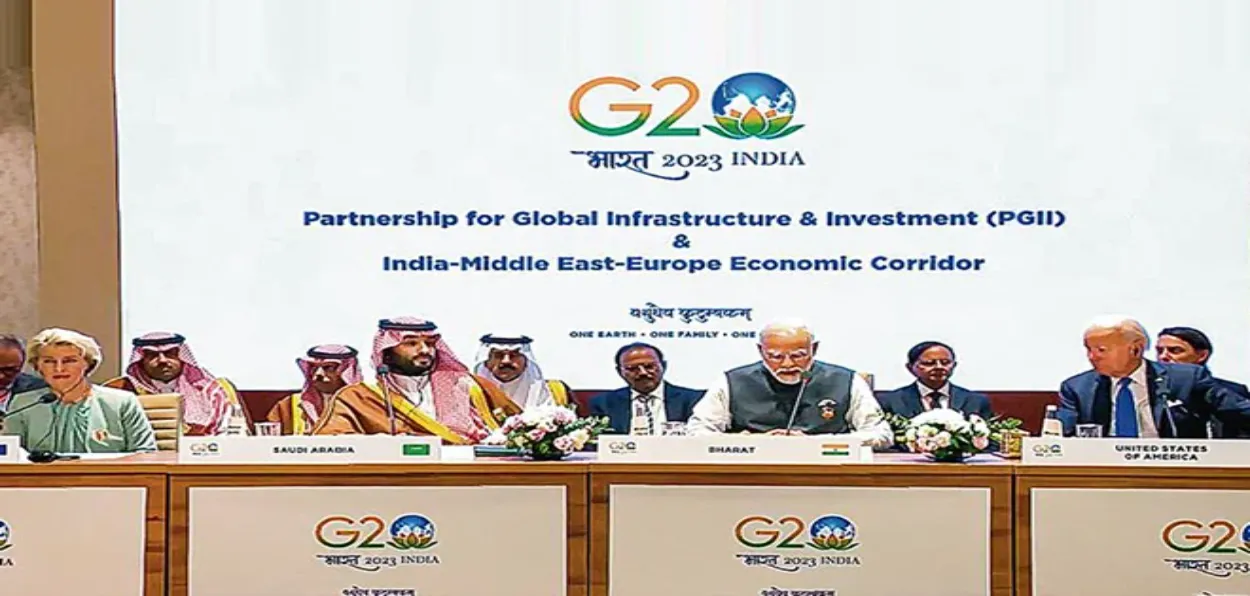
Aditi Bhaduri
At the recently concluded G20 summit in Delhi, a major announcement made was - the launching of the India-Middle East-Europe Economic Corridor (IMEEC). The IMEEC MoU was signed by India, the U.S., Saudi Arabia, UAE, European Union, Italy, France and Germany. The IMEC is envisaged as a multi-modal route connecting India to Europe and further the US through the United Arab Emirates (UAE), Saudi, Arabia, and Israel.
The India-Middle East-Europe Economic Corridor aims to enhance commerce and cooperation between participating countries, with the potential to boost their economic growth and development. It is a significant geostrategic move and has been called a potential game-changer by analysts and stakeholders.
However, before delving into its significance let us first understand what the IMEEC is all about.
The IMEEC seeks to connect Indian ports on India’s West coast (Mundra, Kandla, and Navi Mumbai), with ports in the UAE (Jebel Ali, Fujairah) and in Saudi Arabia (Dammam, Ras al Khair), through which cargo and freight will travel. These will then be transported through Saudi Arabia to Jordan and further to Israeli port in Haifa through an elaborate railways network. From Israel, the route runs to the nearest European port of Piraeus in Greece. While there are major infrastructural gaps in the railways network, this offers an opportunity for further construction of infrastructure and development in the countries concerned. The EU stated that ‘detailed plans’ would be released in October.
The Engineering Exports Promotion Council India (EEPC India) has called the IMEEC a "game-changer", with its chairman Arun Kumar Garodia saying the corridor will also make the “global supply chain more resilient”. Currently, Indian goods access the European market via the Suez Canal. However, the 2021 blockage of the Suez Canal for six days was a huge blow to global supply chains, resulting in losses of billions of dollars. Lloyd’s List, a maritime intelligence portal, estimated the value of goods delayed each hour during the blockage to be at USD 400 million.
Otherwise, too, India has been scouring for alternate routes to Europe to reduce export transportation costs and time. New Delhi has been participating in trade corridors like the International North-South Transport Corridor (INSTC).
The world recently witnessed the third anniversary of the Abraham Accords which first normalized relations between Israel and the United Arab Emirates and also paved the way for the normalization of relations between Israel and Bahrain, and then Morocco. Such peace-making between the countries of the Middle East then spawned trilateral cooperation between India, Israel, and the UAE, making for a regional reorder.
The I2U2 forum, comprising India, Israel, the UAE, and the US was a result of this engagement. As India becomes more integrated with West Asian Economic and security architecture, the IMEEC was entirely a matter of course.
According to the US publication Axios, the IMEEC was floated during talks held over the last 18 months in I2U2, where Israel raised the idea of connecting the region through railways, and "Part of the idea was to use India's expertise on such big infrastructure projects." one source said.
Currently, China is involved in many such infrastructure projects including in railways in the region and it also includes Israel. While Indian participation will not squeeze out China, it will help balance the Chinese presence in the region as well as give an impetus to Indian companies.
According to Goradia, the Middle East and Europe are key markets for India’s engineering exports sector, and having transport infrastructure of this scale will greatly enhance its competitiveness globally, investment in the transformative project will greatly boost economic activities, create jobs, and help reduce carbon footprint.
Critics have focused on major infrastructural gaps that remain, particularly in the railways networks in the corridor, but also in the infrastructure of ports included in the corridor. While these will require humongous effort and resources, they do not render the IMEEC unfeasible.
First, such infrastructural projects dovetail neatly with Saudi Vision 2030 to transform the kingdom into an economic powerhouse as well as with the UAE's ambitions to make the UAE a global transit and logistical hub.
Next, the IMEEC will need cooperation between Saudi Arabia and Israel. The US has long been trying to broker such normalization. However, the Saudis will need major concessions for the Palestinians as part of any such normalization. The successful realization of the IMEEC may incentivize such a breakthrough for the Palestinians.
ALSO READ: How Uzbekistan is evolving as a model Muslim country
Finally, the IMEEC's potential can be gauged from the responses it has elicited from some of those not part of the current IMEC. Turkiye's President Recep Tayyip Erdogan has immediately proposed an alternative route to the IMEC in the Iraq Development Road. Turkiye is another major Mediterranean power. Russia's President Vladimir Putin, on the other hand, has said “I think it is for our good; it will help us develop logistics.......the additional traffic of goods along this corridor will be an addition to our North–South Transport project...... If there is another route, I believe it includes Israel, we will be able to reach the Mediterranean through the Black Sea and use this corridor........"
Aditi Bhaduri is a journalist and political analyst specialising on West and Central Asia
